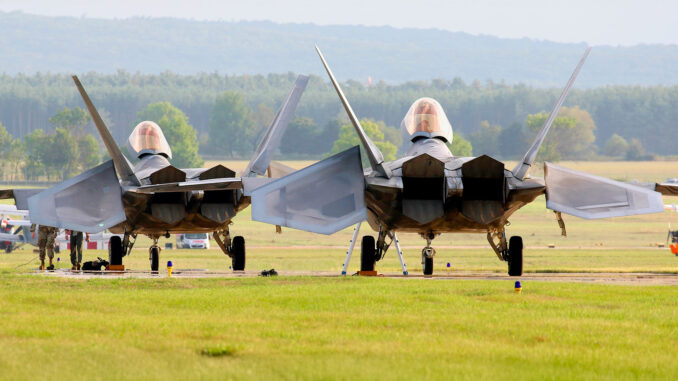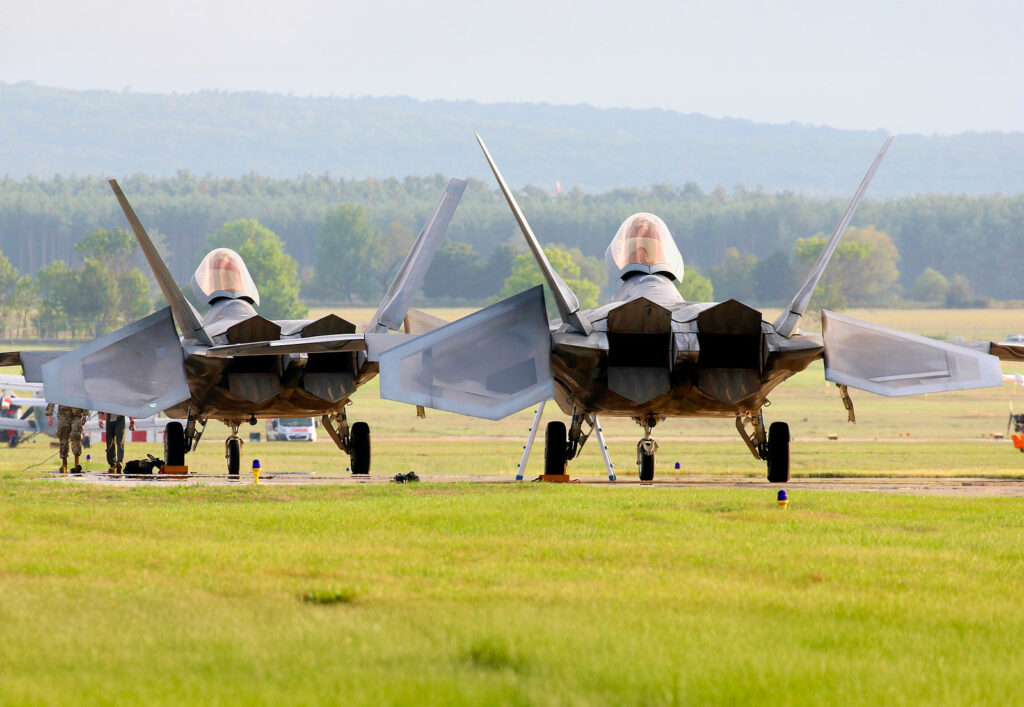
Today’s fighter jets provide secure data links in the face of electronic jamming: how do these networks operate in contested space?
Summary
Modern fighter jets rely heavily on secure tactical data links to share information in real time between platforms and command posts. These systems, such as Link 16, MADL (Multifunction Advanced Datalink) or TTNT (Tactical Targeting Network Technology), enable the exchange of data, voice, and video streaming in scenarios where the adversary seeks to deny the use of the electromagnetic spectrum. In an electronically contested environment, i.e., where jamming, interception, or neutralization are active, it is crucial to have interference-resistant protocols, autonomous mesh networks, fallback modes, and relays. This article details data link concepts, connection mechanisms, their strategic role, the challenges posed by a contested environment, and the technological responses implemented to maintain tactical connectivity.
The concept of fighter jet data links
A data link in a fighter jet is a secure digital channel that enables the real-time exchange of tactical data, voice, and even video between different actors (aircraft, drones, ships, command centers). It is used in particular to:
- share the tactical situation (positions, threats, targets);
- coordinate effects (air-to-air, air-to-ground, joint missions);
- create a common operating picture for multiple platforms.
In practice, a fifth-generation fighter such as the F-35 uses this link to merge its sensors with those of other aircraft and then transmit this information to allied platforms or command nodes.
Data links are an integral part of network-centric warfare: without them, aircraft remain “islands” of information. Relying solely on onboard sensors limits range, responsiveness, and coordination.
Types of connections required and their characteristics
To fulfill its mission, a fighter aircraft needs several types of data connections:
- Air-to-air connection (link between fighters, or even drones);
- Air-to-ground/air-to-ship connection (exchange with command posts, AWACS, ships);
- Ground or satellite connection (for high altitude or offline).
Several protocols or standards are currently recognized:
- Link 16: one of the most widely used tactical standards in NATO, UHF frequency, shared network.
- MADL (Multifunction Advanced Datalink): designed for stealth aircraft, directional communication, Ku band, increased resistance to jamming.
- TTNT (Tactical Targeting Network Technology): low-latency IP mesh network, self-forming, self-healing, resistant to jamming.
Each link must meet specific technical criteria:
- low latency for real-time sharing;
- high bandwidth to carry sensors and video;
- encryption and authentication to prevent interception or spoofing;
- resistance to jamming, out-of-band interception, and electronic attacks.
For example, TTNT enables networking of more than 200 users, with priority assignments for critical flows and multi-hop relays beyond line of sight.
The challenge of an electromagnetically contested environment
An electromagnetically contested environment is an area where the adversary has capabilities for jamming, signal geolocation (SIGINT), neutralization (anti-radiation), and even spectrum closure or satellite censorship. This condition makes data links vulnerable. The RAND Corporation report states that even resilient military data links can be rendered inoperative if a powerful jammer gets close enough.
In this type of theater, several factors degrade connectivity:
- active jamming of traditional radio frequencies;
- detection of the transmission by the adversary, who can then target the transmitter (the aircraft) or the channel;
- saturation or flooding of the channel with parasitic traffic;
- loss of satellite or terrestrial relays (anti-satellite attack or ground disruption);
- the need to operate with reduced bandwidth or to rely on out-of-spectrum links.
This situation imposes several constraints: the aircraft must have adaptive modems, be capable of changing channels and frequencies, use directional or beamforming antennas, and have fallback modes to maintain a minimum level of connectivity. Operational tactics must incorporate link degradation as a mission parameter.

Technologies and methods for ensuring connectivity in this context
Several technical and procedural solutions have been developed to guarantee data connectivity even in contested environments.
Mesh network and self-forming
With links such as TTNT, an aircraft can join an ad hoc mesh network: access does not depend on a fixed centralized infrastructure, which reduces points of vulnerability. Nodes can enter or exit, and routing reconfigures automatically.
Anti-jamming and restricted transmission
Connections such as MADL use directional antennas, narrow beams, frequency hopping, and low-power protocols to limit detection by the enemy. This reduces the transmission signature and offers greater resilience.
Data prioritization and adaptive management
In a contested theater, data flow must be prioritized. Critical information (alerts, fire control, threat data) takes precedence over less urgent flows (video, logistics). TTNT, for example, offers a Statistical Priority Multiple Access (SPMA) protocol to manage this.
Relays and aerial fiber optics
In some scenarios, an aircraft or drone can serve as a relay between distant platforms or those below the line of sight. The RAND report mentions the use of aircraft as relay links in the event of a breakdown in traditional communications.
Cybersecurity and encryption
The data link must be encrypted, with mutual authentication, to prevent the injection of false messages or spoofing. A breach in the credibility of the network can be as damaging as its loss.
Multi-channel redundancy
To ensure continuity, fighter jets often carry multiple link systems (e.g., Link 16 + MADL + satellite + backup link). If one channel goes down, another can take over. Simultaneous use also allows for interoperability with legacy platforms that are not equipped with the latest standard.
Concrete example: interoperability between stealth aircraft and older platforms
The case of the link between the F-22A and the F-35 illustrates the challenges well. The F-22 did not initially have an adequate modern link to communicate with its non-stealth partners. The Talon HATE system (adaptive pod mounted on F-15C) or a Freedom 550 software radio served as a gateway between MADL and Link 16.
This situation highlights several points:
- A modern link (MADL) is useful for stealth aircraft communicating with each other, but is not sufficient for reading or writing with older platforms;
- A data translator or network relay may be necessary to establish connectivity between multiple generations of equipment;
- Interoperability is a major challenge in contested environments, where every second lost or every missing connection can jeopardize operational superiority.
Impact on mission and platform survivability
Having a reliable data link in a contested environment transforms an aircraft from a simple “shooter” into an active node in the combat network. The benefits are numerous:
- Improved threat detection (sensor sharing).
- reduced sensor-to-shooter time (time between threat detection and response);
- better coordination with other platforms (aircraft, drones, ships) and ground/ship effects;
- improved survivability: thanks to the link, an aircraft can receive an alert from another system or act in dispersed coordination to avoid enemy detection or fire.
In modern combat, particularly against advanced air defenses, data links are becoming as important as onboard missiles or stealth capabilities. A platform that loses connectivity can be isolated, detected, and attacked without support. The RAND article points out that in the event of a communications blackout, aircraft must be prepared to operate in a low-bandwidth environment—which drastically reduces their capabilities.
Persistent limitations and challenges
Despite advances, several challenges remain:
- Intensive jamming near an enemy transmitter remains difficult to counter. Even modern links can be rendered inoperative if the enemy has a powerful, silent jammer.
- The problem of sigint/location: transmitting creates a signature. Even directional beams can be located and treated as a threat.
- Interoperability between allies or partners with disparate equipment poses constraints in terms of protocol, encryption, and data translation.
- Cost and logistics: updating systems and maintaining modems, antennas, and relays increases complexity and man-hours.
- Space-time: latency, synchronization, and network architecture must be rigorous. A timing error can render a tactical image obsolete or dangerous.
- Cyber risk: a data link network is susceptible to attack, manipulation, or espionage, especially in a multi-platform and allied environment.
The future of data links for fighter aircraft
To remain effective in a highly contested environment, several areas of development are being explored:
- Increased use of optical or laser air-to-air/air-to-ground networks to avoid the traditional radio spectrum.
- Integration of autonomous relay drones to ensure connectivity in areas without infrastructure.
- the adoption of adaptive AI/ML protocols that automatically modify frequencies, modulation, and power according to the threat;
- the improvement of multi-domain data fusion (air, space, cyber) to enrich and disseminate the tactical situation more quickly;
- Extending very long-range links in “denied” environments using resilient satellites or tactical relays.
One possible future is one in which a fighter jet, an autonomous drone, and a command post are interconnected in a real-time network capable of resisting jamming, automatically reconfiguring itself, and continuing the mission even in the event of a partial outage.
A fighter jet’s ability to maintain a secure data link in an electromagnetically contested environment now determines its role and tactical effectiveness. Link technologies are evolving to meet the threats of the 21st century, but their success also depends on the overall network architecture, doctrine of use, and operational readiness. By combining radar, missiles, stealth, and resilient connectivity, modern fighter jets are becoming not just firing platforms but active nodes in networked warfare.
War Wings Daily is an independant magazine.